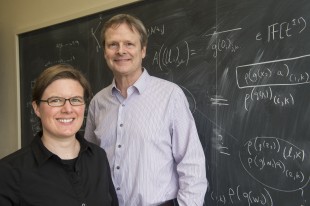Simons Foundation awards grants to Shelly Harvey, Tim Cochran
Rice University mathematicians Shelly Harvey and Tim Cochran have won prestigious fellowships from the Simons Foundation.
They are among 40 North American mathematicians and theoretical physicists to earn the fellowships, which provide faculty members a semesterlong leave from classroom and administrative duties to perform basic research.
Harvey, an associate professor of mathematics, and Cochran, a professor of mathematics, will use their time to work on questions of topology, the study of shapes in multidimensional space. They’ll remain based at Rice, but the fellowship provides travel funds to encourage collaboration with other academics.
The fellowships, which began July 1, will enable Harvey and Cochran to extend their Rice sabbatical leave to a full academic year.
“It’s certainly great that they can focus exclusively on their research for an entire year,” said David Damanik, professor and chair of the Rice Department of Mathematics. “Typically our sabbaticals are for one semester, and one often needs several weeks to get started, to sort out the project to work on.”
Damanik, who was the department’s first Simons Fellow, recalled time moving all too quickly during his sabbatical. “Having a year is much more beneficial than one semester,” he said. “I’m very hopeful and expect them to do great things.”

Rice University mathematicians Shelly Harvey and Tim Cochran are the recipients of prestigious Simons Foundation fellowships. (Photo by Jeff Fitlow)
Harvey and Cochran will work together to solve fundamental problems involving knots in three and four dimensions.
“We specialize in the four-dimensional aspects of knot theory, trying to decide which knots can be unknotted in four dimensions. It’s quite difficult,” Cochran said. “Topology is like geometry, the study of the shapes of things. That’s very important in many applications. We don’t do applied math, but a lot of people do study knotted DNA and linking of DNA strands in order to derive information about the nature of the mechanisms going on in replication.”
He said their work also has implications for imaging in medicine, especially for three-dimensional imaging of internal organs, and for defense purposes.
“The interesting thing about topology is you can study any dimensional space. One and two dimensions have been understood for a very long time,” Harvey added. “For higher dimensions, five and above, they come down to solving algebraic questions.
“Four dimensions is where things change a lot, so it has the most exotic behavior. Our work focuses on the interactions between three and four dimensions,” she said.
“We feel fortunate because few organizations fund research in pure mathematics,” Harvey said of the award. “We’re grateful to the Simons Foundation for their support of our field.”


Leave a Reply